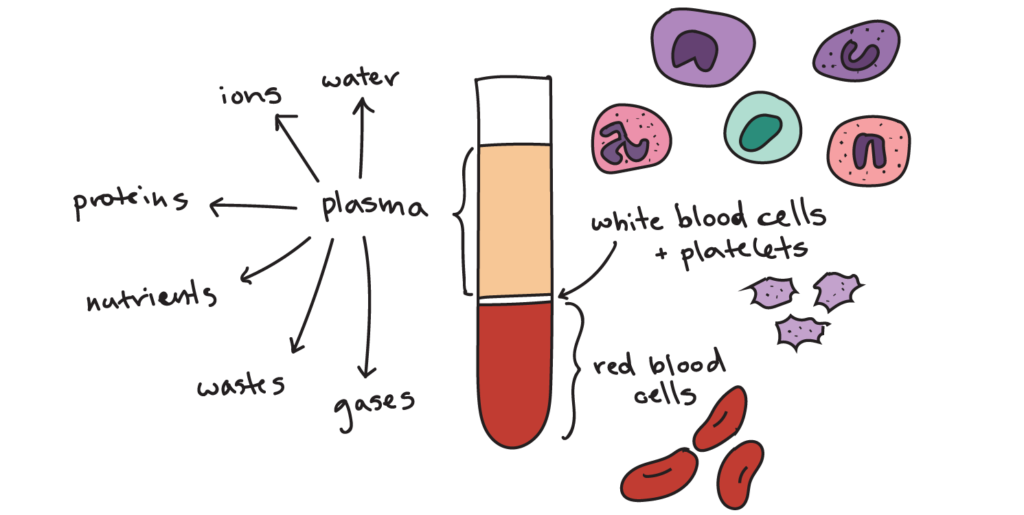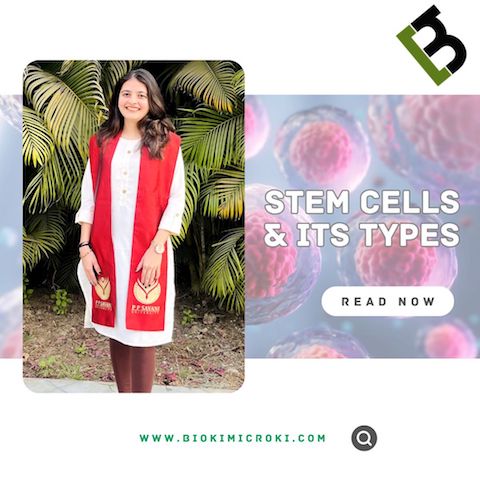Blood
Blood is a red fluid that circulate in arteries and veins of humans and other animals; which provide vital requirements and exchange the gases. Hence, it is one of the most important component of life for animal kingdom. The blood is connective tissue which is fluidic in nature. It is continuously pumped by heart allowing circulation of blood throughout the body. An adult individual carries 5 to 6 liter of blood making around 8% of body weight. Its function is to transport oxygen and nutrients to all tissues and organs of the body. It also carries antibodies that fights with the pathogens. Moreover, it collects the waste products and get filter from kidney allowing to discharge the waste via urinary system.
Blood composition
Blood has two major components: Cellular and Fluid. These components are visibly seen when the blood is centrifuged. The fluidic component is called plasma it is transparent in nature. The cellular component are found in intermediate layer (buffy coat) and the red color bottom layer. The plasma contains nutrients, proteins, vitamins, ions, water, waste and gases whereas the buffy coat carries white blood cells (WBCs) and platelets. The bottom layer contains red blood cells (RBCs).



1. Plasma
Plasma is the peripheral part of blood which contribute 55% to total blood and transport the materials such as nutrients, waste products, clotting factors, electrolytes, etc. from one part of the body to another part by vessels.
Characteristics
- Contain 55% of total blood
- Blood fluid medium.
- Straw yellow in color
- Adult contain 2.7 – 3.0 liter of plasma
- It contains 90% water, 7% protein and 3% other inorganic elements
- It contains albumins, globulins fibrinogen, electrolytes, clotting factors.
- Antibodies are present in plasma.
Serum:
Plasma without clotting factors known as Serum.
Function
- Circulate dissolve nutrients like glucose, fatty acids, amino acid
- Remove waste materials
- Maintain pH
- Plasma establishes osmotic gradient between blood and fluids.
2. Red Blood Cells
Red blood cell (RBC) is flexible, biconcave, non-nucleated cell that are float in plasma. It is also known as Erythrocytes (erythrose – red, cytos – cell)
Characteristics
- Biconcave in shape, increasing surface area volume ratio; this shape favors maximum air exchange of gases.
- They collect oxygen from lungs and carbon dioxide from other tissues and organs. They carry carbon dioxide in the form of carbonate.
- Wide at edge and narrow at center
- 6 to 7 mm in diameter
- It lacks the nucleus and mitochondria
- Life span is 120 days
- It contains hemoglobin (Hb), it is key protein for carrying oxygen
- Normal range Male: 4.7 to 6.1 million cells/mcL; Female: 4.2 to 5.4 million cells/mcL
- Old cells remove by liver and spleen.
- The level of RBCs is maitained by hormone called erythropoitin.
Function
- It takes up oxygen from lungs and circulate throughout the body and release the oxygen in tissue.
- It carries the carbon dioxide from the tissue back to lungs.
- RBC carry enzyme that convert CO2 into bicarbonate.
3. White Blood Cell
White blood cell (WBC) is group of nucleated cells that support in defence process of the body by provide attack on pathogens. WBC is also known as Leukocytes (leukos – white, cytos – cell). There are two types of WBC cells: Granulocytes and Agranulocytes
Characteristics
- WBC cells are produced and derived from multipotent cells in the bone marrow.
- It is present in both blood and lymphatic system.
- WBCs are nucleated cells.
- Smaller in size and number then RBC.
- WBC normal range 4 to 11 X 109 /L
Function
- WBC protect against allergy and parasitic infection
- They secrete and transport heparin, histamine and serotonin.
- They provide immunity
- They are phagocytic in nature.
Types of White Blood Cell
A) Granulocytes
They are types of WBC which contain small particles with enzymes that are present in cytoplasm of cell and released during infections.
There are mainly 3 types
- Neutrophils
- Eosinophils
- Basophils
I. Neutrophils
- Most ample WBC
- Constituting 60 -70% of the circulating WBC
- Defend against bacterial and fungal infection
- First responders to microbial infection.
- They have multilobed nucleus; which consists 3 to 5 lobes connected by slender strands.
- They are active in phagocytosis.
- Life span is 5.4 days.
II. Eosinophils
- Eosinophils compose about 2-4% of the total WBC.
- This count fluctuates throughout the day and during menstruation.
- The nucleus is bi-lobed, connected by thin strand
- Cytoplasm is full of granules.
- It provides responses against allergies, parasitic infection, collagen diseases.
- They secrete chemicals that destroy large parasites.
III. Basophils
- Basophils are 0.5% of the total blood.
- They response against allergic infection and antigen.
- They release histamine.
- The nucleus is bi-lobed and hard to see because of the coarse granules.
- Heparin is and anticoagulant that inhibits blood circulation and promotes the movements of WBC.
- They also release chemical signals that attract eosinophils and neutrophils to an infection site.
B) Agranulocytes
This are the types of WBC which does not contain granules in their cytoplasm.
They are mainly 2 types:
- Lymphocytes
- Monocytes
I. Lymphocytes
- Lycophytes are more common in lymphatic system.
- Constituting 20 – 40% of total WBC.
- They are distinguished by having a deeply staining nucleus that may be eccentric in location and have small amount of cytoplasm.
- Lymphocyte are 2 types: B cells and T cells
- B cells: make antibodies, block pathogen invasion, activate complement system.
- T cells: T helper cell display CD4 receptor
- T cytotoxic cell display CD8 receptor
II. Monocytes
- Largest type of WBC.
- Constituting 3-9% of total WBC.
- Share phagocytosis function with neutrophils
- They provide signal to T cells against pathogen.
- They have kidney shaped nucleus.
- Once monocytes leave the blood stream, they undergo differentiate into macrophages.
3. Platelets
Platelets makes your blood thicker during injury, also involved in clotting. Also known as thrombocytes (thrombos – clot, cytos- cells). The platelets are produced from large bone marrow cells called megakaryocytes. The megakaryocytes undergo fragmentation producing 2000-3000 plateles. This process is controlled and regulated by thrombopoietin. Whenever, we get a wound the platelets get attracted towards the wound and fomrs sticky plug. Further, they activate signal cascade that converts firbrinogen to fibrin. The fibrin and platelets together plays vital role in clotting.
Characteristics
- It lacks nucleus.
- Synthesized in bone marrow.
- Biconvex in shaped.
- 2-3 mm in diameter.
- 150-400 X 109 /liter.
- Found only in mammals.
Function
- Helps in blood clotting
- They have adhesive and cohesive functions which help to coagulate and from haemostatic plug.
- They secret adhesive proteins and coagulation and growth factors.
- Play a role in wound healing
Mechanism
Adhesion: Platelets attach to substances outside the interrupted endothelium.
Aggregation: They connect to each other through receptor bridges.
Haemostasias: Formation of this platelet plug is associated with activation of coagulation cascade with fibrin.


